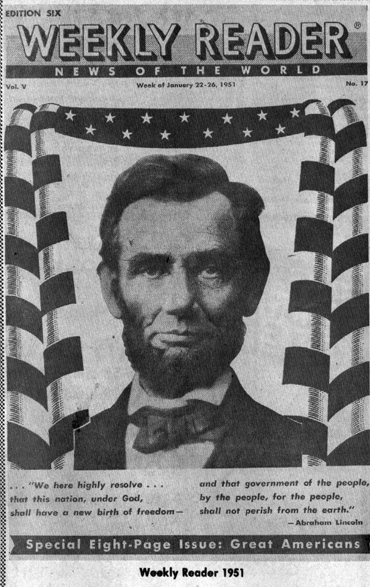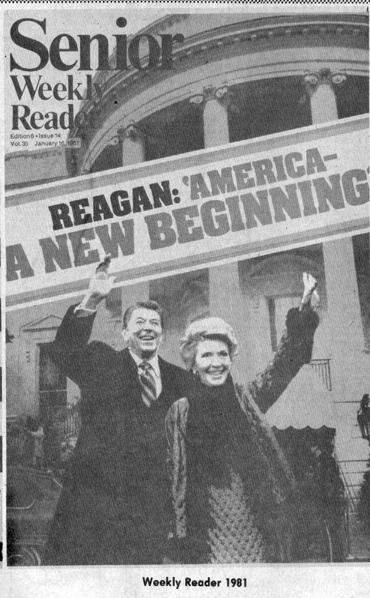October 15, 1981


There’s scarcely a person who doesn’t know about the Weekly Reader used in our schools. Many readers will remember when they were in school and the Weekly Readers which they used as part of their curriculum.
That was the case with Pam Taylor, whom I mentioned in a Potluck Feedback item Aug. 27. She had telephoned me to say that she had a collection of Weekly Readers, which her mother had saved when Pam’s oldest brother was in school about 30 years ago. That telephone call sparked my interest in them and prompted me to inquire of Edna Longacre Gilhuly, a retired local teacher, about the age of the Weekly Reader program.
Edna’s retirement hasn’t dimmed her knowledge of that subject. She told me that the Weekly Reader program is 52 years old and that Eleanor Johnson, the founder and first editor is still living, but no longer holds that position.
Pam Taylor loaned me the collection of Readers dating back to 1950-51. Securing a current copy from Riley School, I found that the Readers today are still the same size, 8 1/2 by 11, but enlarged in number of pages, and still magazine/newspaper style.
GRADED MATERIAL
The Reader is used from kindergarten through sixth grade, and graded according to the age of the users. It appears by comparison that the sixth grade level edition used today is more sophisticated and the content more advanced than those used in 1950-51.
One of the 1950 issues contained a story about General McArthur and the defense of Korea; the Tickle Box column…riddles, quizzes; Pen Pal Club column; Hobby Corner; Dan, Date and Dizzy cartoon strip; and news stories to interest kids.
The January 1981 Senior issue (illustrated) were appropriately devoted substantial space to President Reagan, in addition to the cover. Other subjects in that issue were related to government, as well as regular features.
The September 1981 issue has more advanced content: How the Space Shuttle Will Payoff for You; TOTO to Test Tornadoes; Please Don’t Hit Me Mom…a dialogue on child abuse; sports; Activity Corner (how to build things); Senior Skills (consisting of new vocabulary, news comprehension); crossword puzzle. Another feature in the September 1981 issue explained how to use weather maps…an interesting subject, even for adults.
There wasn’t a Weekly Reader program when your author was a school kid. I wish there had been. Looking over the old and new copies, I am convinced it is an important part of education in the schools if properly presented by the editors and teachers.
My thanks for those who helped me present this article, including Pam Taylor, who prompted my interest by her telephone call.
FEEDBACK: WATKINS HOUSE
That is what the story headline said. However, it should now really be called the Shiff House, the present owner being Stuart Shiff, even though the Lockhart family lived there longer than any other.
Karen Lockhart Purser, San Francisco, daughter of Mr. and Mrs. William Lockhart, both deceased, and granddaughter of Mr. and Mrs. John Lockhart, wrote an interesting letter, part of which is quoted..
“Dear Mr. Krupp – Of course I remember you, and making that walk up and down Main for years!”
Thank you very much for sending me the newspaper account of the Tiffin Street House. You did some real research and I am pleased to have the information. I enjoyed old housed, and although I only lived in that house for three years (from age 2-5) I have very fond memories of it.
I can add some facts and some hearsay. My mother told the story of having a Tiffany light fixture from the dining room hauled off to the dump in 1938 because she found it very ugly. In any event, the original fixture would have been gas. The house I live in in San Francisco was built in 1900 and it was built with both gas and electric fixtures.
I have no recollection of the light fixtures on the stair newel post, and a picture of my father at the age of two, standing on the stairs shows no light fixture then.
I know that my grandmother Laura Green was living in the house in 1898 because I read a diary she had written that year in which she described sitting on the porch and watching the world go by.
How do you account for the door knocker dated 1828? Could this have been added by the older Mrs. Watkins, who I think was an antique dealer? Certainly, if the hardware is consistent throughout the house, it should be possible to get a good estimate of its age.
I have some furniture from that house, a sideboard, several tables, and the dry sink. According to the styles, most appears to have been manufactured about 1870. One of the tables had what looks like “Asire” Fostoria, Ohio written underneath it.
(Author’s Note: Much of the hardware used in homes of that period was manufactured in the New England states. That hardware was probably produced in 1828 and finally found its way into the house during construction years later. The location of what appeared to be a light fixture on the newel post, as mentioned in the story, was undoubtedly added by Mrs. Watkins, during her residency since, as Mrs. Purser said, it was not there in the earlier photo she has.)
Carolyn Cunningham Kark, West Ridge Drive, telephoned to say that James Anderson, named in the story about the Lockhart house, was her great-great grandfather on her father’s side. She has the original deed issued for the house by President Andrew Jackson.
Her father was Harold Cunningham, son of Major George Cunningham, who had a drug store here many years ago. Harold and his brother, George both worked \par in the store. I remember the family well.
According to Carolyn, the Andersons were all Methodists and lived at the corner of Tiffin and Wood Streets where the original land deeded to James Anderson was located.
She too believes that he (James) and Rev. Anderson who founded the first Methodist church in Rome may be one and the same.
MAIN STREET STORY
In that story I listed J.M. Myers, wholesale hay dealer as having an upstairs office above Eaton’s Drug Store. However, I errored in saying that Floyd \par and Morrel were his sons. They were the sons of Smith, another hay dealer located above where the Chamber of Commerce is now. Sorry about that. Mrs. Lloyd Agnew, 220 N. Union St. called that matter to my attention. Mrs. J.M. Myers lives with her daughter, Mrs. George Cranch, 719 N. Main St.
Eugene Stagger, 510 E. Lytle St. – telephoned about the Main Street story too. When the last installment appeared he quickly found his father, Louis Stagger, ex-policeman, deceased in the picture.
Remarking about the second installment of that story, in regard to Mrs. Gilliard having played piano at Fostoria’s first movie house, the Luna on South Main, Stagger said his mother often told about when she played piano for the Majestic Theatre, which was located across from the Colonial. She told how rats would scurry across the floor during the movie showing.
Gloria Miller – 340 McDougal St., telephoned to say she remembered Bazley Meat Market and that you could buy unpackaged meat to suit your choice. Also that there was a hat store there later. Although a younger married reader, Mrs. Miller says she enjoyed Potluck and things historical.
When Mr. Denver House, McCutchenville Rd. had finished reading the three installments of the Main Street Story and looking at the three photos, he easily recognized his father and two brothers, according to his wife.